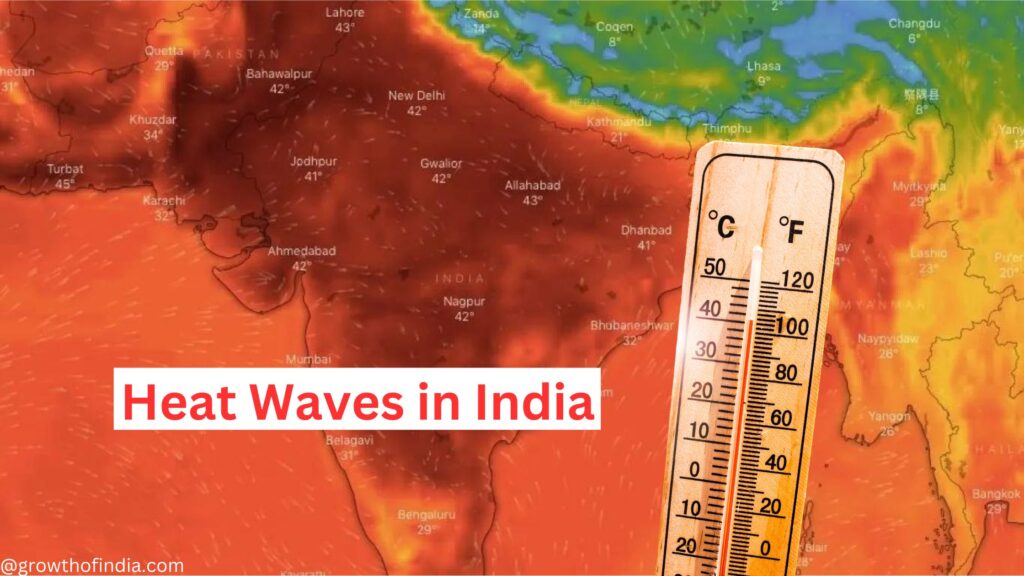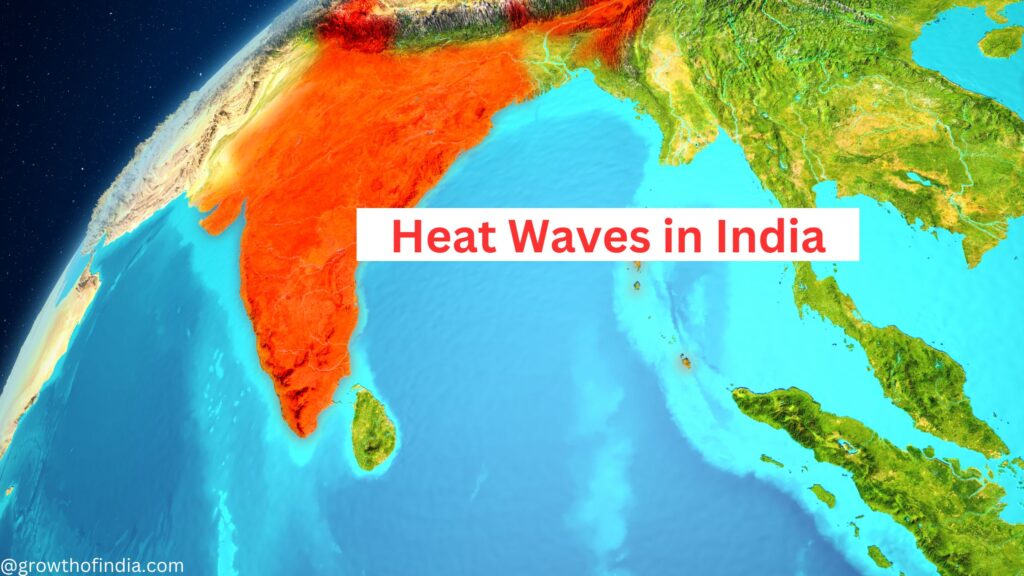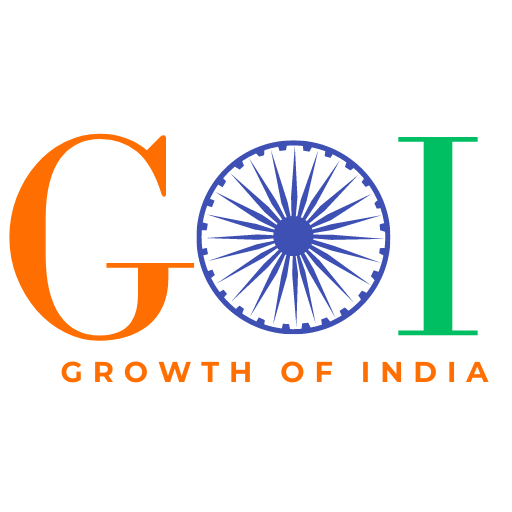Heat Waves in India, India is burning: Our country is burning literally if you look at India from a satellite due to heat waves India looks in the red zone because of high heat waves. At this moment India is hotter than Saudi Arabia, Oman, Sudan, and many other countries like African Countries.
The heat waves are a national emergency and summer has just started this year and is going to be India’s hottest summer we can’t even imagine what will happen in May. This blog is not only to talk about problems at the end of this blog we will discuss the solutions also in which your and my active participation is important.

Let’s see the topic in the chapters about Heat Waves in India and why India is Burning:
Chapter 1: The Heat Is Expensive
The sun’s heat makes India poor it sounds weird to hear, but even today 75% of the Indian population that is 3 out of 4 people do physical labor related to work, they do farming, constructing buildings, setting up stalls on the roadside and sell some stuff and when does this work happen? In the afternoon that is in the burning heat. Similarly, 75% of the is dependent on an unorganized sector which contributes 1/3 rd of our GDP.
Due to the heat productivity drops by 5-10%, and you feel dehydrated you get tired quickly. So if India can’t work because of heat how will it move ahead? You and I are privileged.
We are safe from this heat in our offices so, we face the heat only while traveling. A report by McKinsey says that 20 crore people in India could be affected by heat waves.
The figures say that by 2030 the impact of this productivity loss on GDP will be between 2.5% and 4.5% which is $126 billion every year. Our central government spends about 2% of GDP on education every year, that is if we can save all the losses from the heat wave and allocate all that money saved for education our education budget can be doubled every year.
That is by avoiding economic losses that money can be used for good causes.
If the environment becomes our priority then things can change for good, that is where we see the dream of making India a developed nation by 2047.
Climate change is the reality Sonam Wangchuk sir has been protesting and telling everyone the same for the last 2 months because the climate is quite unbiased it doesn’t matter if you are left-wing or right-wing or which religion you follow climate only looks at facts. And the fact is that India will be the 3rd most impacted country due to climate change.
More than any rank this ranking should be given more importance we think that if the heat is higher then we will turn on the AC but AC doesn’t reduce the heat AC increases the heat why? Because AC runs on electricity and in Inaid most of the electricity comes from thermal power plants like Coal burning them releases carbon and also increases pollution. In international energy data in their World World Energy Report 2023, there are many insights about the usage of AC in India.
In India, there are 24 houses out of 100 have AC, in America 85 out of 100 have AC and in China’s urban area almost every house has AC. In 2050 AC units in use will increase by 9 times this report says that by 2050 our power demand for AC will be more than in the entire Africa which is crazy. Using an AC is a short-term solution but in the long term, it is a problem that can cost us.
Chapter 2: What are Heat Waves?
We understand the heat waves’ impact on our economy but why it can be a national emergency? What are heat waves? Did you ever sit in a sauna? Or in a room where there is no ventilation you start sweating heat waves form when a high-pressure situation is created. Due to high pressures in the upper atmosphere, winds get trapped towards the heat that the ground reflects, and the heat that ground reflects gets trapped in this area and it can’t get out of that area.
Winds can’t come in this high-pressure area and the heat also gets trapped. It is kind of like a pressure cooker. Heatwave is not a season like a summer, winter, or rain, heat wave is a condition, heat wave is declared only when the temperature goes above a particular limit.
As per IMD for Plains, 5 degrees above the main temperature or crosses 40 degrees. In hilly areas 5 degrees above the main temperature or crosse 35 degrees. In coastal areas 5 degrees above the main temperature or crosse above 37 degrees.
The economy is linked to people’s productivity and it is connected to happiness and people’s happiness is connected to temperature. We have invented many things to overcome cold like jackets, making a small fireplace, and insulating our homes so that cold winds don’t come inside. But our cities have not found any solution to beat the heat.
When India was ranked 126th out of 146th countries on the happiness index we felt bad some people asked how valid this happiness index is but we have to take one step forward we have to think about how the changing environment is affecting our mood our productivity and our economy, all these things are connected this is the truth.
According to a study, the temperature of modern buildings is 5 to 7 degrees higher you must have seen such houses in many big cities where many people cannot afford a roof so they put a metal roof 37% of Mumbai houses are like this if you look at the map of Mumbai you can see that the temperature is the lowest around Aarey forest. and where the trees are less the temperature increases this is called the Urban Heat Island Effect.

Chapter 3: Solutions for Heat Waves In India.
If we have to beat the rising temperature in India then we have to stop copying Western ideas blindly we perfectly learn those things from the West, which we shouldn’t for example observe the New York skyline here you can see many glass buildings looking at these tall glass buildings the need to have an office in such buildings to achieve corporate success rises and thus the same was copied and followed in India do you realize why they build glass buildings?
In New York, the average temperature in summer is 27 degrees Celsius, and in Mumbai, it is 35 degrees Celsius which means Mumbai is hot, humid, and tropical and in New York, it snows in winter. But what difference does it make if there are glass buildings in Mumbai? At the same time, two suns are formed because the glass buildings reflect the sunlighting and create a double sun effect which means double light and double heat, In Cities like Mumbai where there are only two seasons summers, and extreme summers aren’t glass building a bad idea? The people working in glass building experience this phenomenon while traveling yet they don’t even realize it. Copying the West has now become a fashion.
If we have to copy then why can’t we copy Singapore? Their climate is similar to ours we also have the problem of space. And yet, buildings look something like this there are vertical gardens that make the most of limited spaces. We need to change our mindset.
In Gurukul, the children were taught to plant 1 peepal tree, 1 tamarind tree, 3 amla trees, and 5 mango trees. A mango tree produces 271 tons of oxygen in its entire lifetime and absorbs 81 tons of carbon it is the same amount of carbon that 5 ACs emit. If they are used for 1000 hours. What we take from nature.
Isha Upanishad teaches us that this universe that is made up of living and non-living is created by God. we can just borrow all these things, resources, water, fruits, and flowers we we don’t own them, so let’s take a step forward this year to plant more and more trees. Don’t through the mango seeds after eating them mango wash the mango seeds properly, and keep them under the sun for some days so that they dry properly. And then you can plant a tree in open spaces near your home or any garden.
By doing this there are 3 benefits.
1. your waste will be reduced.
2. the mango trees will be planted and
3. we can donate all these trees to our farmers so that they can have an income source in the future
We hope you like the above information on Heat Waves In India you can also follow Abhiandniyu on Instagram and share this with your friends and family so that they can also gain knowledge about this topic.
For more interesting blogs visit our website GrowthOfIndia.com
